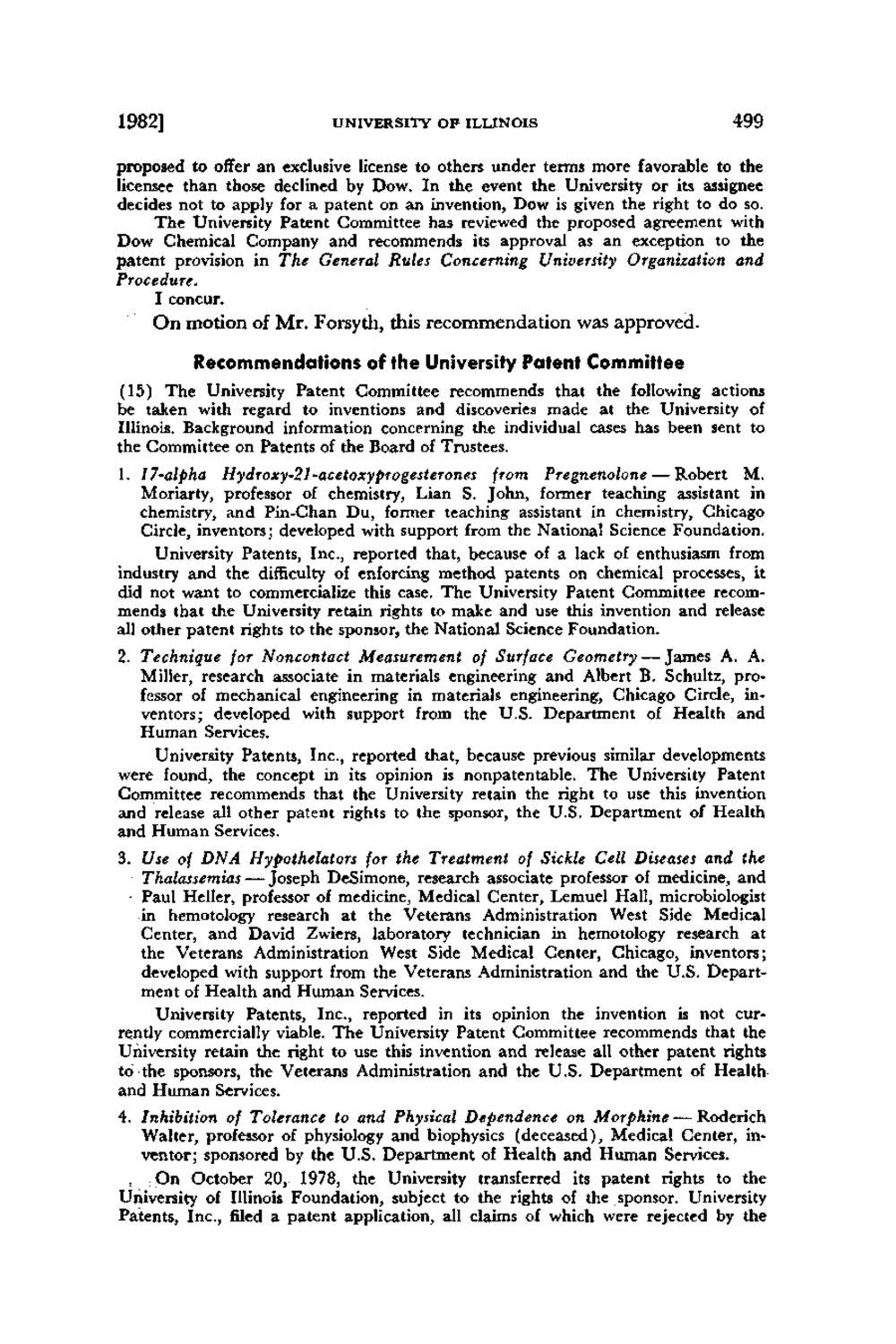| |
| |
Caption: Board of Trustees Minutes - 1982
This is a reduced-resolution page image for fast online browsing.

EXTRACTED TEXT FROM PAGE:
1982] UNIVERSITY OF ILLINOIS 499 proposed to offer an exclusive license to others under terms more favorable to the licensee than those declined by Dow. In the event the University or its assignee decides not to apply for a patent on an invention, Dow is given the right to do so. The University Patent Committee has reviewed the proposed agreement with Dow Chemical Company and recommends its approval as an exception to the patent provision in The General Rules Concerning University Organization and Procedure. I concur. O n m o t i o n of M r . F o r s y t h , this r e c o m m e n d a t i o n w a s a p p r o v e d . Recommendations of the University Patent Committee (15) The University Patent Committee recommends that the following actions be taken with regard to inventions and discoveries made at the University of Illinois. Background information concerning die individual cases has been sent to the Committee on Patents of the Board of Trustees. 1. 17-alpha Hydroxy-21-acetoxyprogesterones from Pregnenolone — Robert M. Moriarty, professor of chemistry, Lian S. John, former teaching assistant in chemistry, and Pin-Chan Du, former teaching assistant in chemistry, Chicago Circle, inventors; developed with support from the National Science Foundation. University Patents, Inc., reported that, because of a lack of enthusiasm from industry and the difficulty of enforcing method patents on chemical processes, it did not want to commercialize this case. The University Patent Committee recommends that die University retain rights to make and use this invention and release all other patent rights to the sponsor, the National Science Foundation. 2. Technique for Noncontact Measurement of Surface Geometry — James A. A. Miller, research associate in materials engineering and Albert B. Schultz, professor of mechanical engineering in materials engineering, Chicago Circle, inventors; developed with support from the U.S. Department of Health and Human Services. University Patents, Inc., reported diat, because previous similar developments were found, the concept in its opinion is nonpatentable. The University Patent Committee recommends that the University retain the right to use this invention and release all other patent rights to the sponsor, the U.S. Department of Health and Human Services. 3. Use of DNA Hypothelators for the Treatment of Sickle Cell Diseases and the Thalassemias — Joseph DeSimone, research associate professor of medicine, and Paul Heller, professor of medicine, Medical Center, Lemuel Hall, microbiologist in hemotology research at the Veterans Administration West Side Medical Center, and David Zwiers, laboratory technician in hemotology research at the Veterans Administration West Side Medical Center, Chicago, inventors; developed with support from the Veterans Administration and the U.S. Department of Health and Human Services. University Patents, Inc., reported in its opinion the invention is not currently commercially viable. T h e University Patent Committee recommends that the University retain the right to use this invention and release all other patent rights to the sponsors, the Veterans Administration and the U.S. Department of Health and Human Services. 4. Inhibition of Tolerance to and Physical Dependence on Morphine — Roderich Walter, professor of physiology and biophysics (deceased), Medical Center, inventor; sponsored by the U.S. Department of Health and Human Services. , O n October 20, 1978, the University transferred its patent rights to the University of Illinois Foundation, subject to the rights of die sponsor. University Patents, Inc., filed a patent application, all claims of which were rejected by the
| |